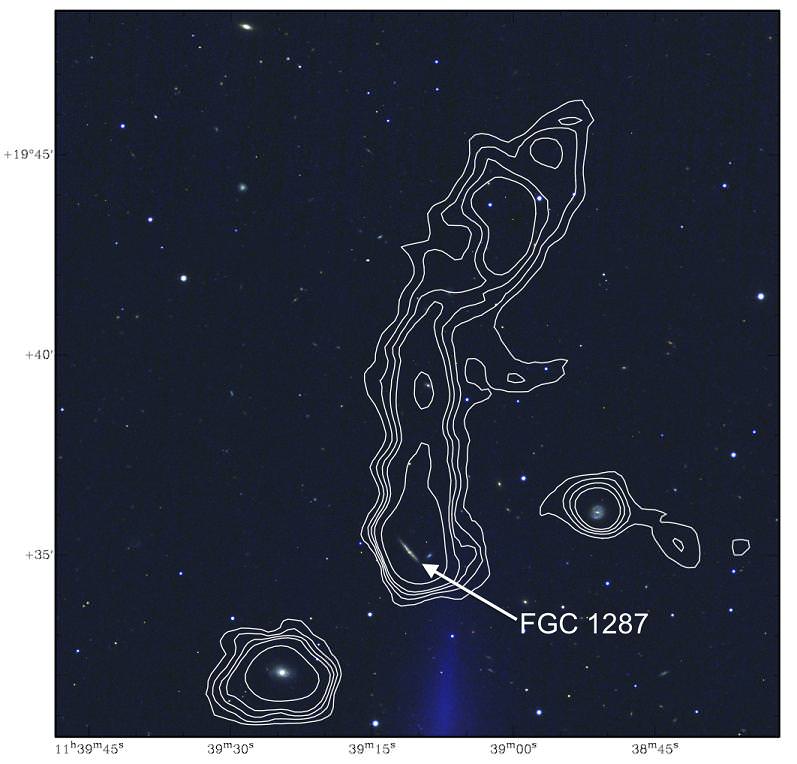[/caption]
When it comes to understanding how galaxies behave both inside and outside of galaxy clusters, it would seem that we still have quite a lot to learn. Tom Scott from the Instituto de Astrofisica de Andalucia in Granada, Spain, and a group of international astronomers have been busy with the Expanded Very Large Array (EVLA) of the National Radio Astronomy Observatory (NRAO) in the USA, checking out an assortment of galaxies associated with galaxy cluster Abell 1367. What they have found is unexpectedly long one-sided gaseous tails in two sets of galaxies… the longest of their type ever observed.
Located in the constellation of Leo and about 300 million light years away, galaxies CGCG 097-026 and FGC1287 are displaying gaseous tail structures that may rearrange thinking on how stripping of materials behaves. Current thinking has hot gases trapped within the galaxy cluster’s gravitational field – with incoming galaxies being depleted of their cold hydrogen gases when captured by the gravitational influence. Through this impact, galaxies added to the cluster generally tend to lose their star-forming abilities and begin to quickly age. Astronomers assume this is why less aggressive galaxy structures tend to be found in lower density environments. However, thanks to Scott’s research, astronomers might be able to assume that galaxies can be robbed of their gases before entering a clustered environment.
“When we looked at the data, we were amazed to see these tail structures” says Tom Scott. “The projected lengths of the gaseous tails are 9 to 10 times that of the size of the parent galaxies, i.e., 520,000 and 815,000 light years respectively. In both cases the amount of cold hydrogen gas in the tails is approximately the same as that remaining in the galaxy’s disk. In other words, these galaxies have already left behind half of their fuel for star formation before entering the sphere of influence of the cluster.”
As stated, the commonly accepted theory for gaseous tail structures is interaction with the hot, gaseous medium located within the cluster’s influence – a process known as ram-pressure stripping. But this case is different. Galaxies CGCG 097-026 and FGC1287 aren’t being perturbed by the nearby cluster just yet… But they are still displaying long tails of material.
“We considered the various physical processes proposed by theorists in the past to describe gas removal from galaxies, but no one seems to be able to explain our observations” says Luca Cortese, researcher at ESO-Garching, Germany, and co-author of this work. “Whereas in the case of CGCG97-026, the gravitational interaction between the various members of the group could explain what we see, FGC1287 is completely different from any case we have seen before.”
Right now, ram-pressure stripping isn’t the answer – and gravitational interactions don’t seem to fit the picture, either. It’s leaving scientists at a loss to explain these long tails and lack of stellar disturbance.
“Although the mechanism responsible for this extraordinary gas tail remains to be determined, our discovery highlights how much there still is to learn about environmental effects in galaxy groups” says team member Elias Brinks, a scientist at the University of Hertfordshire. “This discovery might open a new chapter in our understanding of environmental effects on galaxy evolution.”
Original Story Source: Royal Astronomical Society News Release. For Further Reading: Two long tails in the outskirts of Abell 1367.

